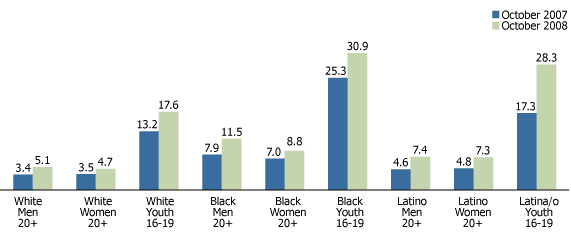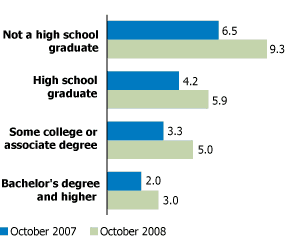
U.S. Employment Instability on the Margins
(December 2008) The impact of the devastating financial crisis on the U.S. workforce is becoming clear. Numerous economic indicators have pointed downward following the federal government’s $700 billion bank bailout in October 2008. Indeed, various corporations and industries are seeking financial assistance from the federal government with threats of job cuts if they are not made solvent.
The number of employed Americans has declined by 1.2 million over the first 10 months of 2008, with half of the loss taking place since August.1 The result is that the October national unemployment rate of 6.5 percent represents the highest level of unemployment since March 1994.2 Many economists predict a worsening employment situation with the jobless rate expected to rise to anywhere from 7 percent to 9 percent over the next couple of years.3
While the impact of the weakening economy is widespread, it disproportionately affects those on the margins of the labor force, such as persons of color, teenagers, and those with low levels of education.
Disproportionate Job Losses
Between October 2007 and October 2008, the national unemployment rate rose from 4.4 percent to 6.1 percent.4 However, while unemployment rates have increased across the board, some workers have experienced a higher proportion of job losses. For example, blacks and Latinos 20 years of age and older have sustained greater increases in their unemployment rates compared with whites (see Figure 1), with black and Latino men suffering the biggest increases in joblessness. Blacks currently have the highest unemployment rates, with black men at the top (11.5 percent).
Teenagers have been even more susceptible to job losses. This is especially the case among Latino teens whose unemployment rate soared from 17 percent in October 2007 to 28 percent in October 2008. Currently, about three in 10 black and Latino youth are unemployed (versus about one in six white youth). Given the high dropout rates among Latino youth, it is likely that many are not in school, resulting in greater marginalization.
Figure 1
Unemployment Rates for Selected Groups, October 2007 and October 2008

Source: Bureau of Labor Statistics, 2008.
Note: The white and black categories include Latina/os who identified with the respective racial category.
Education Matters
All workers 25 years of age and older, regardless of educational level, have endured rising unemployment over the last year. However, those without a high school diploma have sustained the greatest increase in joblessness—climbing from 6.5 percent in October 2007 to 9.3 percent in October 2008 (see Figure 2). Indeed, high school dropouts are more than three times as likely to be unemployed as those with at least a bachelor’s degree.
Figure 2
Unemployment Rates for Persons 25 Years of Age and Older in the Civilian Labor Force by Educational Attainment Level, October 2007 and October 2008.

Source: Bureau of Labor Statistics, 2008.
Implications
The current economic situation is the worst the United States has faced in decades. All indicators point to continued deterioration of economic conditions in the coming year or two. Many workers have already lost their jobs and many others will soon join the ranks of the unemployed.
Yet, workers on the margins—blacks, Latinos, youth, and the least educated—are at the forefront of the job losses. The household income of non-U.S. citizen, foreign-born individuals from Latin America has eroded significantly over the last year as well.5 Many of these individuals and their families have barely eked out a living even during more robust economies. The current economic crisis will make it much more difficult for persons on the margins, especially since they face other major challenges related to housing, health insurance, and increasingly job stability. Recent increases in food and gasoline prices only make matters worse.
Rogelio Saenz is professor of sociology at Texas A&M University. The author acknowledges the helpful comments of Karen Manges Douglas on an earlier draft of this article.
References
- Bureau of Labor Statistics, The Employment Situation: October 2008, accessed online at www.bls.gov/news.release/pdf/empsit.pdf, on Nov. 18, 2008.
- Bureau of Labor Statistics, Labor Force Statistics From the Current Population Survey, accessed online at http://data.bls.gov/PDQ/servlet/SurveyOutputServlet?data_tool=latest_numbers&series_id=LNS14000000, on Nov. 18, 2008.
- Money Magazine, “2009: Year of the Thaw,” accessed online at http://money.cnn.com/2008/11/04/pf/forecast_economy1.moneymag/index.htm?postversion=2008110414, on Nov. 18, 2008; and Rex Nutting, “Unemployment Expected to Hit 9%, Wachovia Economists Say,” accessed online at www.marketwatch.com/News/Story/Story.aspx?guid=%7BD7A29379-B5AC-41F3-8977-842BCB3B3B6A%7D, on Nov. 18, 2008.
- The data used in this report are drawn from the Bureau of Labor Statistics, The Employment Situation: October 2008. The unemployment rates for October 2007 and October 2008 are not seasonally adjusted.
- Rakesh Kochhar, Sharp Decline in Income for Non-Citizen Immigrant Households, 2006-2007, accessed online at http://pewhispanic.org/files/reports/95.pdf, on Nov. 18, 2008.
